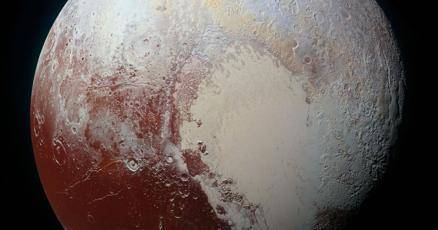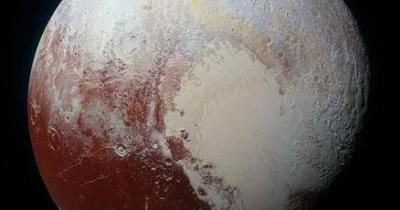An international team of astrophysicists has made significant progress in understanding the heart-shaped feature on Pluto's surface, informally known as "Tombaugh Regio." NASA's "New Horizons" spacecraft captured images of this icy feature in 2015, and scientists are trying to decode how this unique structure formed. After years of intensive research, the international astrophysics team revealed the most likely explanation behind its mysterious formation: an "ancient impact." In Pluto's early years, it was struck by an object approximately 400 miles wide (about 700 km) at an unusual angle, resulting in this surface feature.
The study was conducted by the University of Bern and members of the National Centre of Competence in Research (NCCR) PlanetS, including the University of Arizona in Tucson. The unique geological formation consists of two parts: the bright heart-shaped "Sputnik Planitia" and the surrounding dark area "Cthulhu Macula." "Sputnik Planitia" is a frozen plain covering an area of 1,000 kilometers, located in the western part of "Tombaugh Regio." This vast area is equivalent to a quarter of the size of Europe or the United States.
To reconstruct this strange heart-shaped feature, researchers utilized computational simulations using the Smoothed Particle Hydrodynamics (SPH) method. They discovered a series of simulations that produced close matches, indicating that the surface feature resulted from a "slow, giant angled impact." Martin Gützi from the University of Bern stated, "The elongated shape of Sputnik Planitia strongly indicates that the impact was not a direct hit but rather an angled collision."
Research suggests that the area was affected by a collision with a planetary body roughly 700 km in diameter during Pluto's early years. According to the press release, this planetary body was "about twice the size of Switzerland from east to west." The bright appearance of Sputnik Planitia is due to it being mostly filled with white nitrogen ice, which is constantly moving and transferring heat to smooth the surface.
Harry Ballentine, the principal author from the University of Bern, explained that this nitrogen likely accumulated quickly after the impact due to low elevation. The new simulations provided fresh insights into Pluto's internal structure, contradicting previous ideas. Furthermore, the research suggests that Pluto does not have a subsurface ocean, contrary to previous assumptions. According to former scientific theories, Pluto, like other planetary bodies in the outer solar system, might contain a liquid water ocean beneath its surface.
The unusual location of the heart feature near the planet's equator led scientists to speculate that it could be attributed to liquid water beneath the region. Gützi remarked, "The new research indicates that a liquid ocean is not necessary to explain the position of Pluto's heart." However, scientists propose an alternative explanation: "In the simulations we conducted, Pluto's primitive mantle was entirely dug through by the impact, and as the material from the impacting body scattered onto Pluto's heart, it created a local excess that could explain the migration toward the equator without the presence of an underlying ocean, or possibly just a very thin ocean."




